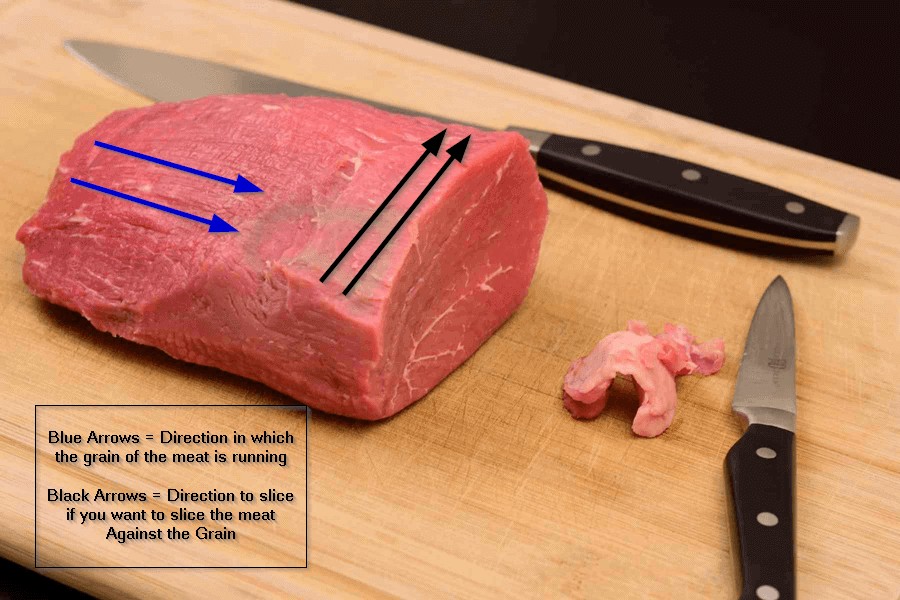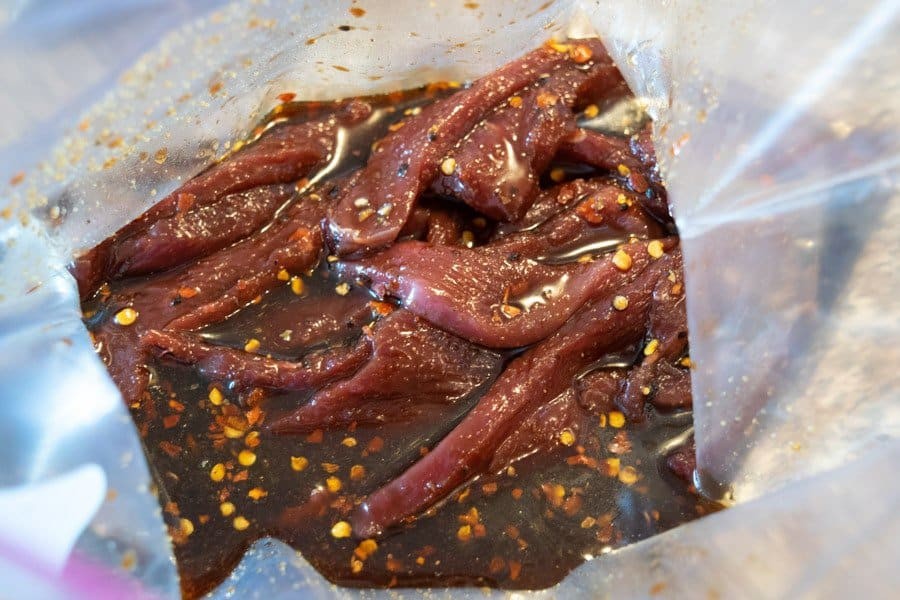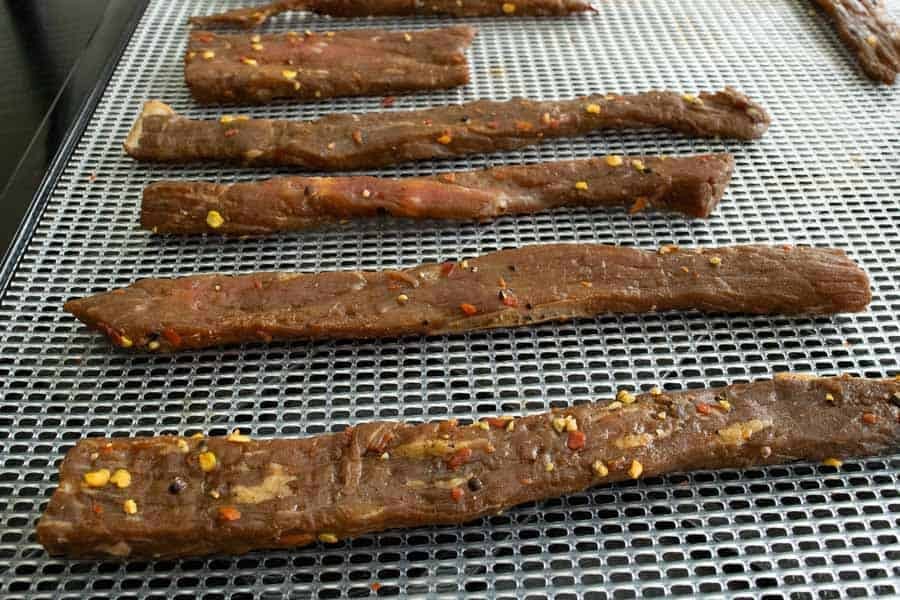Unlock the secrets to crafting delectable, homemade beef jerky with our comprehensive guide on How To Make Beef Jerky In A Food Dehydrator. At FOODS.EDU.VN, we believe everyone can enjoy the art of creating healthy, delicious snacks right in their own kitchen. Discover the techniques for selecting the finest cuts of meat, perfecting flavorful marinades, and achieving the ideal jerky texture. Dive in to learn how to create unforgettable snacks using your food dehydrator, mastering the art of preservation and flavor infusion. Explore savory recipes, expert tips, and the science behind beef jerky, all designed to empower you with the knowledge to create preservative-free, personalized treats.
1. Understanding the Allure of Homemade Beef Jerky
The appeal of homemade beef jerky extends far beyond just having a tasty snack. It’s about crafting something uniquely yours, controlling every ingredient, and enjoying the satisfaction of a job well done. Store-bought jerky often contains preservatives, artificial flavors, and excessive sodium. Making your own beef jerky allows you to avoid these additives and customize the flavors to your exact liking. Here’s why making beef jerky at home is a rewarding experience:
- Healthier Option: Control the sodium content, avoid artificial additives, and use leaner cuts of meat.
- Customizable Flavors: Experiment with different marinades and spices to create unique flavor profiles.
- Cost-Effective: Making jerky in bulk can be more economical than buying pre-made versions.
- Sense of Accomplishment: There’s a special satisfaction in creating a delicious snack from scratch.
- Perfect for Gifting: Homemade beef jerky makes a thoughtful and personalized gift for friends and family.
2. Essential Equipment and Ingredients for Making Beef Jerky
Before diving into the process, let’s gather the essential tools and ingredients you’ll need to succeed. Having the right equipment not only makes the process smoother but also ensures consistent results.
2.1. Core Equipment
| Equipment | Description | Why It’s Important |
|---|---|---|
| Food Dehydrator | An appliance specifically designed to remove moisture from food, preserving it for longer periods. | Provides consistent, low-temperature drying, crucial for jerky’s texture and safety. |
| Sharp Knife or Jerky Slicer | A high-quality knife for trimming and slicing the meat evenly. A jerky slicer ensures uniform thickness. | Ensures even drying and prevents some pieces from being under or over-dried. |
| Cutting Board | A sturdy surface for slicing meat safely and efficiently. | Protects your countertops and provides a stable surface. |
| Mixing Bowls | Used for preparing the marinade and ensuring even distribution of flavors. | Allows ingredients to blend properly, creating a balanced flavor profile. |
| Ziplock Bags or Containers | For marinating the meat and storing the finished jerky. | Ensures the meat is fully submerged in the marinade and provides airtight storage for freshness. |
| Kitchen Thermometer | Essential for monitoring the internal temperature of the meat to ensure it reaches a safe level (160°F/71°C). | Guarantees the jerky is safe to eat by killing harmful bacteria. |




2.2. Selecting the Right Meat Cuts
Choosing the right cut of meat is crucial for achieving the desired texture and flavor in your beef jerky. Lean cuts are ideal because fat can cause the jerky to spoil faster and have an unpleasant texture.
Top Choices for Beef Jerky
- Eye of Round: This is a very lean and affordable cut, making it an excellent choice for beginners.
- Top Round: Another lean option that’s slightly more tender than the eye of round.
- Bottom Round: Similar to top round, but can be a bit tougher, making it ideal for those who prefer a chewier jerky.
- Flank Steak: A flavorful cut with a good balance of tenderness and chewiness.
- Sirloin Tip: A leaner option that’s also relatively tender and flavorful.
2.3. Essential Ingredients for Marinade
The marinade is where you infuse your beef jerky with flavor. Here’s a list of essential ingredients that form the foundation of a delicious marinade:
Base Liquids
- Soy Sauce: Adds umami and saltiness.
- Worcestershire Sauce: Provides a complex savory flavor.
- Liquid Smoke: Imparts a smoky flavor, especially if you’re not using a smoker.
Flavor Enhancers
- Garlic Powder: Adds a pungent and aromatic flavor.
- Onion Powder: Provides a subtle, sweet onion flavor.
- Black Pepper: Adds a touch of spice and depth.
- Red Pepper Flakes: For those who like a bit of heat.
- Brown Sugar: Balances the savory flavors and adds a hint of sweetness.
- Salt: Enhances the other flavors and acts as a preservative.
Optional Additions
- Honey or Maple Syrup: Adds sweetness and helps with browning.
- Vinegar (Apple Cider or Balsamic): Adds acidity and tenderizes the meat.
- Hot Sauce: For extra heat and flavor.
- Ginger: Adds a warm and spicy note.
- Sesame Oil: Provides a nutty and aromatic flavor.
FOODS.EDU.VN Tip: “Experiment with different combinations of these ingredients to create your own signature marinade. Don’t be afraid to try new flavors and adjust the ratios to suit your taste preferences.”
3. Step-by-Step Guide: Making Beef Jerky in a Dehydrator
Now that you have your equipment and ingredients ready, let’s walk through the process of making beef jerky in a dehydrator.
3.1. Preparing the Meat
- Choose Your Cut: Select a lean cut of beef from the options mentioned above.
- Trim the Fat: Trim off any visible fat from the meat. Fat can spoil the jerky and affect its texture.
- Partial Freeze: Place the meat in the freezer for 1-2 hours until it’s partially frozen. This makes it easier to slice thinly and evenly.
3.2. Slicing the Meat
-
Slicing Thickness: Aim for slices that are about 1/8 to 1/4 inch thick.
-
With or Against the Grain:
- With the Grain: Results in a chewier jerky.
- Against the Grain: Produces a more tender jerky.
-
Use a Sharp Knife or Slicer: Use a sharp knife or a jerky slicer for consistent slices.
-
Consistent Width: Ensure all slices are the same width to promote even drying.
3.3. Preparing the Marinade
-
Combine Ingredients: In a bowl, whisk together your chosen marinade ingredients. A basic recipe might include:
- 1 cup soy sauce
- 1/2 cup Worcestershire sauce
- 2 tablespoons brown sugar
- 1 tablespoon garlic powder
- 1 tablespoon onion powder
- 1 teaspoon black pepper
- 1 teaspoon red pepper flakes (optional)
- 1 teaspoon liquid smoke (optional)
-
Adjust to Taste: Taste the marinade and adjust the seasonings as needed.
3.4. Marinating the Meat
- Combine Meat and Marinade: Place the sliced meat in a ziplock bag or container and pour the marinade over it.
- Ensure Even Coating: Make sure all the meat is fully coated with the marinade.
- Marinate in the Refrigerator: Marinate the meat in the refrigerator for at least 6 hours, or preferably 12-24 hours. The longer it marinates, the more flavorful it will be.
- Turn Occasionally: Turn the bag or container occasionally to ensure even marination.
3.5. Drying the Jerky
- Preheat the Dehydrator: Set your dehydrator to 160°F (71°C).
- Arrange the Meat: Remove the meat from the marinade and pat it dry with paper towels to remove excess liquid. Arrange the slices on the dehydrator racks, making sure they are not touching or overlapping.
- Dry the Jerky: Dehydrate the jerky for 4-6 hours, or until it reaches the desired texture.
- Check for Doneness: The jerky is done when it bends and cracks but doesn’t break in half. You should also see white fibers within the meat.
3.6. Cooling and Storing
- Cool Completely: Once the jerky is done, remove it from the dehydrator and let it cool completely on a wire rack.
- Store Properly: Store the jerky in an airtight container, ziplock bag, or vacuum-sealed bag.
- Shelf Life:
- Ziplock Bags: 1-2 weeks at room temperature.
- Vacuum-Sealed Bags: 1-2 months at room temperature.
- Refrigerator: Up to 6 months.
- Freezer: Up to 1 year.
4. Expert Tips and Tricks for Perfect Beef Jerky
Here are some additional tips and tricks to help you make the best beef jerky possible:
- Use a Meat Thermometer: Ensure the internal temperature of the jerky reaches 160°F (71°C) to kill any harmful bacteria.
- Rotate Trays: Rotate the dehydrator trays every few hours to ensure even drying.
- Don’t Overcrowd: Avoid overcrowding the trays to allow for proper air circulation.
- Adjust Drying Time: Adjust the drying time based on the thickness of your slices and the humidity in your environment.
- Experiment with Flavors: Try different marinades and spice combinations to create unique flavor profiles.
5. Troubleshooting Common Issues
Even with the best instructions, sometimes things don’t go as planned. Here are some common issues and how to troubleshoot them:
- Jerky is Too Tough:
- Cause: Over-drying, slicing with the grain, or using a tough cut of meat.
- Solution: Reduce drying time, slice against the grain, or use a more tender cut of meat.
- Jerky is Too Soft:
- Cause: Under-drying or not removing enough fat.
- Solution: Increase drying time and ensure you trim off all visible fat.
- Jerky is Spoiling Quickly:
- Cause: Insufficient drying, not trimming enough fat, or improper storage.
- Solution: Ensure the jerky is fully dried, trim all visible fat, and store it in an airtight container in a cool, dry place.
- Jerky Lacks Flavor:
- Cause: Insufficient marinating time or a weak marinade.
- Solution: Marinate the meat for a longer period and adjust the marinade recipe to your taste preferences.
6. Advanced Techniques: Elevating Your Jerky Game
Once you’ve mastered the basics, you can explore advanced techniques to take your beef jerky to the next level.
6.1. Using Curing Salts
Curing salts, such as Prague powder #1 (sodium nitrite), can be added to the marinade to help preserve the jerky and prevent bacterial growth. They also add a characteristic cured flavor.
- How to Use: Follow the instructions on the curing salt package carefully. Typically, you’ll use a small amount (e.g., 1 teaspoon per 5 pounds of meat) and mix it thoroughly with the marinade.
- Safety: Curing salts should be used with caution, as they can be harmful if ingested in large quantities. Always follow the recommended dosage and keep them out of reach of children.
6.2. Adding Smoke Flavor
If you want to add a more intense smoke flavor to your jerky, you can use a smoker in addition to the dehydrator.
- How to Smoke: Smoke the meat at a low temperature (around 160°F/71°C) for 1-2 hours before transferring it to the dehydrator to finish drying.
- Types of Wood: Experiment with different types of wood chips, such as hickory, mesquite, or applewood, to create different smoke flavors.
6.3. Incorporating Unique Ingredients
Don’t be afraid to get creative with your marinade ingredients. Here are some ideas for adding unique flavors to your beef jerky:
- Fruits: Pureed fruits like pineapple, mango, or cranberries can add sweetness and acidity.
- Vegetables: Roasted garlic, sun-dried tomatoes, or jalapenos can add depth and complexity.
- Spices: Exotic spices like cardamom, cumin, or coriander can create unique flavor profiles.
- Alcohol: A splash of bourbon, rum, or beer can add a boozy kick.
7. Exploring Flavor Variations: Recipes to Try
Here are a few delicious beef jerky recipes to get you started:
7.1. Classic Teriyaki Beef Jerky
- 1 cup soy sauce
- 1/2 cup brown sugar
- 1/4 cup rice vinegar
- 2 tablespoons sesame oil
- 2 cloves garlic, minced
- 1 teaspoon ginger, grated
- 1/2 teaspoon red pepper flakes (optional)
7.2. Spicy Southwestern Beef Jerky
- 1 cup Worcestershire sauce
- 1/2 cup tomato paste
- 1/4 cup apple cider vinegar
- 2 tablespoons chili powder
- 1 tablespoon cumin
- 1 tablespoon smoked paprika
- 1 teaspoon cayenne pepper
- 1 teaspoon garlic powder
- 1 teaspoon onion powder
7.3. Sweet and Savory Maple Bacon Beef Jerky
- 1/2 cup maple syrup
- 1/4 cup soy sauce
- 2 tablespoons bacon bits
- 1 tablespoon apple cider vinegar
- 1 teaspoon smoked paprika
- 1/2 teaspoon black pepper
- 1/4 teaspoon garlic powder
8. Health and Safety Considerations
Making beef jerky at home is a safe and enjoyable process, but it’s important to follow proper food safety guidelines to prevent foodborne illnesses.
- Use a Meat Thermometer: Ensure the internal temperature of the meat reaches 160°F (71°C) to kill any harmful bacteria.
- Handle Raw Meat Properly: Wash your hands, cutting boards, and utensils thoroughly after handling raw meat.
- Store Jerky Properly: Store the jerky in an airtight container in a cool, dry place to prevent spoilage.
- Be Aware of Allergies: If you’re making jerky for others, be aware of any potential allergies they may have.
9. Beef Jerky and the Keto Diet
Beef jerky can be a great snack for people following a ketogenic diet. It’s high in protein, low in carbs, and can help you stay in ketosis. However, it’s important to choose or make jerky that doesn’t contain added sugars or other high-carb ingredients.
- Check the Labels: If you’re buying pre-made jerky, check the labels carefully to ensure it’s keto-friendly.
- Make Your Own: The best way to ensure your jerky is keto-friendly is to make it yourself using low-carb marinades and sugar-free ingredients.
10. The Environmental Impact of Homemade Jerky
Making your own beef jerky can also be more environmentally friendly than buying pre-made versions. You can reduce waste by using reusable containers and buying meat in bulk. Additionally, you have control over the ingredients and can choose to support local and sustainable farms.
11. Beyond Beef: Exploring Other Jerky Options
While beef jerky is the most popular type of jerky, you can also make jerky from other types of meat, poultry, and even fish.
- Turkey Jerky: A leaner alternative to beef jerky.
- Chicken Jerky: Another lean option that’s easy to make.
- Venison Jerky: A flavorful and gamey jerky.
- Salmon Jerky: A healthy and delicious seafood jerky.
FOODS.EDU.VN Insight: “The possibilities are endless when it comes to making jerky. Experiment with different types of meat and flavors to create your own unique jerky creations.”
12. FAQ – Frequently Asked Questions
1. What is the best cut of beef to use for jerky?
The eye of round is a lean and affordable option. Other good choices include top round, bottom round, flank steak, and sirloin tip.
2. How thick should I slice the meat for jerky?
Aim for slices that are about 1/8 to 1/4 inch thick.
3. How long should I marinate the meat for jerky?
Marinate the meat in the refrigerator for at least 6 hours, or preferably 12-24 hours.
4. What temperature should I set my dehydrator to for jerky?
Set your dehydrator to 160°F (71°C).
5. How long does it take to dehydrate jerky?
Dehydrate the jerky for 4-6 hours, or until it reaches the desired texture.
6. How do I know when the jerky is done?
The jerky is done when it bends and cracks but doesn’t break in half.
7. How long does homemade jerky last?
Homemade jerky will last for 1-2 weeks in a ziplock bag at room temperature, 1-2 months in a vacuum-sealed bag at room temperature, up to 6 months in the refrigerator, or up to 1 year in the freezer.
8. Can I use curing salts when making jerky?
Yes, curing salts can be added to the marinade to help preserve the jerky and prevent bacterial growth. Follow the instructions on the curing salt package carefully.
9. Is beef jerky keto-friendly?
Yes, beef jerky can be a great snack for people following a ketogenic diet, as long as it doesn’t contain added sugars or other high-carb ingredients.
10. Can I make jerky from other types of meat besides beef?
Yes, you can also make jerky from turkey, chicken, venison, salmon, and other types of meat, poultry, and fish.
13. Resources for Further Exploration
To deepen your knowledge of beef jerky and related culinary arts, here are several reputable resources to explore:
- USDA Food Safety and Inspection Service: Provides guidelines on safe meat handling and preparation.
- National Center for Home Food Preservation: Offers research-based recommendations for home food preservation methods.
- Food Blogs and Culinary Websites: Websites like Serious Eats and Allrecipes offer a wealth of recipes and cooking tips.
- Books on Meat Curing and Preservation: Look for books by experienced butchers and chefs that cover the science and art of meat curing.
14. Conclusion: Your Journey to Jerky Mastery Begins
Learning how to make beef jerky in a food dehydrator opens a world of culinary possibilities. At FOODS.EDU.VN, we’re dedicated to helping you explore the joys of homemade snacks and mastering the art of food preservation. We encourage you to use this guide as a starting point, experiment with flavors, and share your creations with friends and family. Remember to prioritize safety, have fun, and enjoy the delicious results of your hard work.
Ready to explore even more culinary adventures? Visit FOODS.EDU.VN today for a treasure trove of recipes, techniques, and expert advice to elevate your cooking skills. Whether you’re looking for detailed guides, innovative recipes, or inspiration to create your own culinary masterpieces, FOODS.EDU.VN is your ultimate destination for all things food.
Address: 1946 Campus Dr, Hyde Park, NY 12538, United States
WhatsApp: +1 845-452-9600
Website: foods.edu.vn